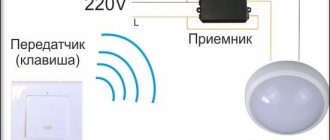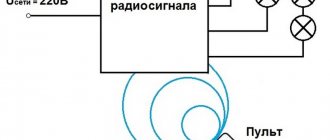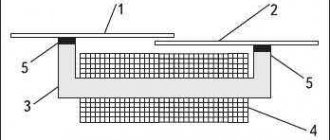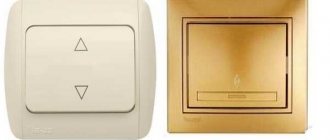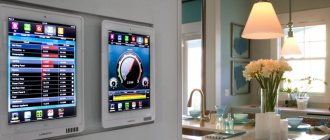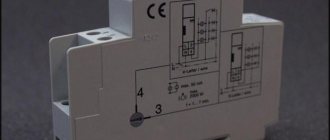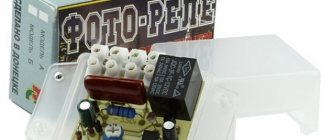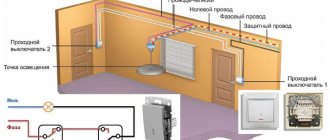One of the effective ways to improve everyday comfort in the home is to switch from conventional to remote control of lights. In this case, the lighting turns on automatically for any event - opening a door, movement, a signal from a remote control or mobile phone, according to a timer, etc. Let’s look at what a remote lighting control system is, how it works and what tasks it allows to solve, what are its pros and cons, what options exist for use in a private home.
Programming parameters in the control unit allows you to automatically set the level of illumination depending on the time of day Source electrica.net.ua
Controlling light from a distance - what is it, circuit options, tasks to be solved
The ability to turn on and off lighting in the house and in the surrounding area from a distance is carried out using special technical devices. There are several options for such control schemes:
- General.
It is used when several lamps need to be turned on or off at the same time. This control scenario is necessary, for example, when there is no time to go around and check all the rooms before leaving the house.
To complete the task, so as not to open the common electrical panel every time, a special controller is used. It is installed at the entrance and combines a group of main lamps that need to be de-energized upon leaving the house.
A special unit can simultaneously control several lamps Source siteapi.org
- Remotely.
Technically, remote switching on of light is carried out in several ways:
- Push-button remote control. Suitable for turning on and off lamps mounted in several tiers, as well as for controlling outdoor lighting - illumination of the house, on the site, in a bathhouse, barn, gazebo, greenhouse and other structures.
- By computer. Using a special program that interacts with the smart home system, you can turn on and off the main lamps of the house and the surrounding area. Moreover, this method is accessible both directly from the home itself and from any other place via the Internet.
- Mobile gadget. A special mobile application allows you to perform a similar procedure from a smartphone, tablet or laptop.
In addition, the lighting can be turned on and off by sending a special code SMS from a regular mobile phone.
Smartphone software effectively controls the light in the house Source lightcomplect.ru
- Automatically.
Lighting devices turn on depending on the signal coming from 3 main types of devices:
- Sensors. In most cases, an IR motion sensor is used. Ultrasonic, microwave and other types of detectors can also be installed.
- Photo relay. The lamp begins to work only when natural light decreases to a certain level, that is, at dusk.
- Timer. The device turns on strictly according to the specified schedule.
The operating principle of the devices is based on the interaction of two main modules - a sensor that sends a signal to a specific event, and a receiver that detects the signal and sends a command to turn on the lamp.
See also: Catalog of companies that specialize in electrical work of any complexity
Problems to be solved
Remote control of light from a remote control, sensor, timer, computer or gadget allows you to solve the following number of problems:
- Comfortable lighting control. It will take less time and effort to turn the light on or off.
- Energy saving.
- Stabilization of illumination characteristics.
- Combining a group of lighting devices into a single system.
- Automation of light control.
The light control system integrates and controls all the lamps in the house Source amperasmart.ru
- Turning lighting on and off according to a given scenario.
- Increased security level. Eliminates the need to walk through the dark to reach the light switch.
- Strengthening security. Turning on the lights for movement in most cases deters intruders who want to enter the territory and the house.
- Possibility of integration with other systems for controlling home electrical equipment.
On a note! To control the light inside the house, it is enough to use IR sensors. Their range does not exceed 10 m, which is quite enough for a room. However, if you need to install a similar system outside the home, it is better to use radio wave analogues that can operate over several tens of meters.
How to choose a remote switch
When selecting a remote light switch, you need to pay attention to many different factors and parameters. Of course, first of all, do not forget that the interior design should be supported even in such small things as the light switch.
If you want to decide on the design of the switch in advance, before purchasing, evaluate the models by viewing photos of remote switches on the Internet.
The kit should always include instructions that will tell you how to connect the remote switch.
It is imperative that the price matches the quality of the model. To do this, it is better to choose well-known manufacturers of electrical equipment. If you are not well versed in this matter, be sure to consult at the point of sale.
And don’t skimp on quality; cheap models are unlikely to last you a long time, which is why it’s better to choose more expensive models. You can connect any of these switches with your own hands, since the current voltage is not high.
Just recently, remote switches were a novelty on the market, but now they are a modern and popular device that makes people's lives easier and more comfortable. If you have already decided to purchase such a switch, this article will tell you how to choose a remote switch.
Advantages and disadvantages
The ability to control the light from a remote control or other control device has the following advantages:
- Availability of installation and connection.
- Smooth adjustment of lighting characteristics of lamps.
- Programming a schedule for turning the lights on and off, creating a “presence effect”.
- Optimization of energy consumption.
- Saving the working life of lamps.
Saving energy and extending the service life of lamps are the main advantages of a light control system Source avtcom.ru
- Turning on and off several lighting devices at the same time.
- Monitoring the safety of electrical appliances at home.
The disadvantages of systems for controlling lighting devices at a distance are manifested in the high cost of equipment and the influence of extraneous factors on the nature of their operation, for example, such as precipitation for outdoor devices, as well as the movement of warm air indoors.
Manufacturers
The most famous models presented on the Russian market are “Ecosvet” and “Claps”. Let's look at their main characteristics.
Switch "Сlaps"
One of the newest developments is the “Claps” cotton switch model. In this device, the sound is processed using a microprocessor; it does not react to any extraneous noise, but is tuned to several claps in a row (this is the most important operating condition).
It is permissible to install several such switches in one room, each of them will react to a certain number of claps, and accordingly turn on the light, humidifier, fan, TV or stereo system. This switch model is suitable for any household appliances that have an electrical cord.
Perhaps to some, the clap switch may seem like a toy or a completely unnecessary device. Others, on the contrary, are passionate about the idea of creating their own “smart home” so that lights and electrical appliances turn on and start working on command or clap. Arrange your life the way you want, but at the same time make it as comfortable as possible.
Ecolight switch
The Ecosvet device is designed to work with 220 Volt light bulbs.
Main parameters of the device:
- load - 300 Watt;
- sound signal spread - from 30 to 150 decibels;
- housing protection level - IP30;
- permissible temperature range - from 20 degrees below zero to 40 degrees above zero;
- cost - from 350 rubles.
“Ekosvet” is fixed with self-tapping screws using the mounting legs. It is not recommended to install the device in noisy rooms. Despite the fact that “Ekosvet” is configured to clap, false alarms are possible.
The figure above shows the device connection diagram. "Ecolight" is connected to a conventional switch to provide the ability to de-energize the circuit and stop its operation.
Lighting control options
Remote turning on of the light can be done from a remote control or switch, in automatic mode or manually, with or without the ability to change the lighting characteristics, as well as on the principle of supplying a signal of certain wavelengths and receiving them. However, when looking for a lighting control system for their own home, the user first of all faces the problem of choosing between the following options:
- Remote control.
The equipment on the remote control operates in both radio wave and infrared radiation frequencies. However, the 1st option is most often used. Since the IR remote control works very limitedly - at a short distance, in a strictly specified direction and so that there is no obstacle in the path of the receiver, that is, it will no longer work behind a wall.
The light is turned on and off using the remote control Source ytimg.com
The radio remote control has much greater capabilities, as it allows:
- Integrate the control system with a PC, smartphone and other gadgets.
- Significantly expand the range limit - up to 100 m or more, and through obstacles - up to 25 m.
- Strengthen the signal with a special repeater.
The radio remote control runs on battery power. In this case, the equipment package includes a remote controller. It is mounted on the wall surface or directly into the lighting fixture.
- IR and radio wave switches.
These are switches that look similar to classic switches. There are models with both a remote control and manual ones, which allow you to turn the light on and off directly by pressing a key. The design includes a special antenna that receives the signal.
Interaction with lighting devices is carried out through special power units connected to the electrical network and lamps. During installation, the switch is placed in a suitable place where it is most comfortable to use; the blocks are installed in the distribution box or directly in the lamp.
Connection errors
The main problem during installation is always not taking into account the power of consumers. For most touch-sensitive light switches, the maximum throughput load is limited to 1 kW. In no case should it be exceeded. Most devices of this type do not contain safety elements that block excessive load. Hence their relative fire hazard when the maximum is exceeded.
Another relatively common mistake when installing 220V touch-sensitive light or energy switches is the incorrect connection of the contact groups. For example, it has been noticed more than once that they try to separate the zero of the power supply network with a control device, instead of a phase. Of course, this creates significant problems in its functioning; it becomes simply impossible.
The practical connection of a phase and a COM port for end devices does not make much sense. However, its purpose is different - to communicate with other switches or pass-through switches.
Briefly about the main thing
You can control the lighting in your home and surrounding area from a distance. For this, several options are used - common for several lamps, remote control, PC or smartphone, and automatic using sensors and a timer. The use of remote control solves many important problems - improving comfort, saving energy, stabilizing lighting characteristics, combining lighting devices, automating control, enhancing security, improving security, and the ability to combine with other home systems.
Main advantages:
- Availability of installation.
- Smooth adjustment of parameters.
- Specified operating mode.
- Optimization of electricity consumption.
- Extending the service life of lamps.
- Ability to turn on and off multiple devices.
- Strengthening control over electrical equipment.
Disadvantages are the need for financial costs and the possibility of interference with work. At the same time, several options are available for controlling the lighting in the house - using a remote control, a radio wave switch with a light control unit and motion sensors. Each method has its own characteristics and scope of application.
The best manufacturers
At the moment, there are not many companies that produce Wi-Fi circuit breakers. However, there is still competition, and they have to maintain their position in the market and be responsible for quality.
Here are some of them:
- French company Legrand. It has been on the market for a long time, has proven itself well, and produces a large line of products under the Celian brand.
- Vitrum (Italy). They were the first to introduce Z-Wave technology into their circuit breakers, which made it possible to completely mechanize lighting control.
- Delumo. A Russian company that, in addition to wireless switches, produces dimmers and thermostats.
- Kopou (China). In addition to switches, it also produces various types of dimmers, including in the form of key fobs and other designer items.
- Livolo (China). In addition to wireless switches, the company produces all kinds of devices and other types of automation systems to simplify home and industrial life. Produces frames for switches.
- Xiaomi. Offers its own Aqara line. These are usually key switches with software and physical control.
The Belarusian company Noolite is also popular among many consumers on the Russian market and has not yet lost its position.
Varieties
These switches do not boast a wide variety of models, but there are plenty to choose from.
They differ according to 3 main criteria:
- Control type.
- Possibility of adjusting the degree of illumination.
- The number of lighting devices they control.
Based on the above, the following types of these devices are distinguished:
- Light delay function. For example, your child does not sleep without light. Installing this gadget allows you to turn off the lights at a certain time. That is, you know after what time your child falls asleep, the light will turn off automatically.
- Ability to configure multiple channels. This allows you to turn on several products at the same time.
- Touch switches. They work by touch.
- Wireless (Wi-Fi controlled) and radio controlled models.
Area of application of the devices
The scope of use of wireless devices is very wide. Models are installed in apartments where there is a need to install a changeover switch or to move an old traditional switch, but this is hampered by the structural features of the room, household appliances and furniture.
In case of urgent need, a wireless switch can be installed not only on the wall, but also on a mirror or inside one of the cabinet shelves. Regardless of its location, the module will function efficiently and provide comfortable control of lighting fixtures
To correct the errors of incorrectly made wiring, you no longer need to dismantle the external decoration of the walls and punch new grooved channels. The problem will be instantly solved by installing a wireless switch. It can be placed in any convenient place, forever forgetting about the difficulties associated with the home lighting system.
Installing a wireless device is the least labor-intensive and cheapest way to ensure comfortable control of the lighting system. The switch can be installed even in rooms with high humidity and sudden temperature changes
Lack of free space in a living space is another reason for installing a wireless module. The device can be placed in a minimal area and even built into any piece of furniture.
For wooden buildings, where electrical wiring equipment is associated with increased security measures, wireless elements are more than relevant. Of course, you can organize external wiring, however, this does not always match the interior and often spoils the attractiveness of the room.
In addition, exposed electrical wires are vulnerable to mechanical damage from residents, children and animals. To protect yourself and your home, it is wiser to install wireless modules and no longer worry about a force majeure situation (fire, short circuit, etc.) resulting from wire damage.
Organizing hidden wiring in a wooden building is problematic and unsafe. An overhead wireless switch will be a lifesaver for owners here. You don't need to call an electrician to install it. The work is simple and even an inexperienced home craftsman can handle it.
If the room is divided into locations, each of which requires its own type of lighting, it is not at all necessary to do a huge amount of work and run wiring to all the switches.
It is enough to simply install a wireless device that can control several light sources and use the remote control to turn on or off the lighting fixtures as needed.
When all repair work in a room has been completely completed and the walls are decorated with a finishing coating (wallpaper, fabric, paint, tiles, laminate, etc.), but there is an urgent need to install another switch, there is no point in dismantling the finishing and punching additional groove channels.
It is better to install a practical wireless device. This will take a minimum of time, and the appearance of the room will not be affected in any way.
To control the lighting system in large cottages, conference rooms, long corridors and other large spaces, wireless modules are simply created. They allow you to turn on the light while being at a great distance from the room or even from the street.
If the building has historical value (antique houses, museums, etc.) and making changes to the interior solutions is considered unacceptable, it is worth using wireless switches. They will provide full control of the lighting system and will easily “hide” in pieces of furniture, without giving away their presence and belonging to modern life.
Increasing the comfort of your home is an excellent reason to install a wireless system. It will allow owners to control the lighting of rooms and utility rooms, literally, with one click of a button and adjust the light intensity according to personal needs and preferences.
WHICH PROTOCOL IS BETTER?
Above we described various options for how controlled-type outdoor lighting can be organized. In each individual case, the control device must be placed either in the control box (electrical panel) or connected to the lighting installation.
This option for organizing street lighting control has obvious advantages:
- the ability to use the most effective control methods immediately (motion sensors, timer, etc.);
- minimize the risk of system failure. If there are complementary elements, the risk of lack of light in a particular area is zero;
- exclusion of the human factor, etc.
But in order to organize a combined type of street lighting and urban infrastructure, you need to know the following nuances:
- where the electrical panel or lighting control box is located. This is necessary to know in those situations when elements of controlled devices, as when using a photo relay, need to be placed in a switchboard;
Switches in the panel
- how the control device is connected to a particular lighting installation or control box;
- operating conditions of lighting control devices. This is very important, since for each device (motion sensor, photo relay, etc.) manufacturers indicate specific operating conditions under which they can guarantee high-quality and long-term operation of the devices in changing street conditions.
These nuances are typical not only for the combined type of lighting control, but also for specific single situations. They should definitely be taken into account when organizing a controlled outdoor lighting system with your own hands and in your own backyard. This type of lighting arrangement can be easily combined with a security system.
System components exchange information and commands using a specific code - a data transfer protocol. The LonWorfcs, LanDrive, KNX, DALI, MyHome, HDL Buspro protocols are widely used. Some, say LonWorks or KNX, provide primarily wired data transmission, although other options for exchanging information are also possible.
Read more: Septic tanks “Chistok”: overview of the model range and installation rules
Review of popular DV models
Similar electrical equipment is produced by manufacturers from different countries.
Popular Wookee radio switches
Remote devices produced by this company consist of a kit that includes a radio signal receiving unit and a remote control. For comfortable use, the set also includes a holder. Specially made holes on it make it easy to attach this part to a vertical surface using ordinary self-tapping screws.
The models are equipped with two switches, thanks to which the devices can operate with different electrical networks. The maximum load in each can reach 500 W. The operating radius of the device is 100 meters in open space and 20 meters indoors. In order for the device to work correctly, it is recommended to install it together with the relay in the junction box.
"Nootechnics" - based on infrared waves
A well-known Belarusian company produces a line of switches with remote control based on infrared radiation “Sapphire”. The models presented in the series are made of high quality polymers, predominantly white in color.
Remote switches of the Sapphire brand are produced in a wide range. Their action is based on the principle of exposure to infrared radiation. Models differ in both design and technical characteristics
The products are equipped with dimmers that allow you to regulate the power of the energy flow, which extends the life of the lamps. The parameters set during the last switch-on are saved when the device is started again, and this reduces the time for selecting the desired brightness parameter.
Many models provide a function to simulate the presence of the owner in the house, associated with periodic turning off/on of lamps in the house. The disadvantages of the models from this company include low-sensitivity sensors, which makes manual control difficult: for correct operation, all manipulations must be performed with the palm of your hand.
German quality and Jung brand design
The well-known German company producing electrical products pays attention to both high-quality mechanisms and impeccable design.
Models of remote light switches produced at the enterprises of this company have a standard set of functions, high build quality, and the use of first-class parts and components. A wide range of variously designed products allows you to choose a model that will fit perfectly into the most sophisticated interior.
The company's catalog includes a line of anthracite appliances (with black polished surfaces), bright models made of acrylic and colored glass, universal products of traditional shapes made of steel and aluminum, and affordable devices made of plastic.
A separate series includes devices with moisture protection, which are intended for use in rooms with a high content of water vapor, for example, in bathrooms.
Practical models "Master Kit"
The most popular devices of this brand are remote switches MK343 and MK344. The first option allows you to remotely switch over two independent radio channels (the permissible power of each is 300 W).
Moreover, if the power unit is equipped with a radiator, the device can withstand a power of 1000 W. To control the device, a keychain transmitter equipped with four buttons is used.
A more advanced modification is the MK344 model, which provides not only on/off, but also smooth adjustment of light intensity through two separate channels.
All functions can be performed using 4 buttons on the remote control: two of them are used to supply the load, and the remaining two are used to control the brightness of the lamps.
Compact and easy to use SOSO
The company specializes in producing small wireless switches. Such devices, capable of operating at high power (up to 3.5 kW), can be placed in a mounting box behind a power switch or socket.
A compact remote device having the size and shape of a regular lamp. The original configuration allows you to place the device in a regular chandelier socket. No wiring required
The power unit in this case is mounted as follows. Having selected the appropriate load indicator, you must turn off the power to the network. Similar to a conventional switch, a power unit is installed, which must be connected to phase and neutral.
The diagram shows the installation of the SOSO ACM-1000 radio switch in the installation box. The wires are connected using terminal blocks; twisting is not recommended
The mains phase wire (brown) passes through the terminal block and is supplied to the L-terminal of the power block, while the zero wire is attached to terminal N. The socket, in turn, is connected to the block output terminals N and L, after which the device can be installed on it .
It is also important to activate the command memory mode, for which you need to press the corresponding button. After this, you need to send a signal from the radio remote control. An indicator of storing this information is the LED blinking twice.
The following article, which is entirely devoted to this interesting issue, will introduce you to the rules and guidelines for choosing a wireless light switch.
Design
Based on their design and application features, dimmable light switches are divided into two groups:
- Modular design;
- Designed for installation instead of conventional switches.
Modular switches are not intended for domestic use and are mounted in power switchboards. They usually dimm entrance lighting.
The most common design of modular devices has push-button dimming. A single press of the button turns the lighting on or off, and a long press (more than 5 seconds) allows you to enter the adjustment mode and set the desired output voltage level.
Some models have additional adjustment of the maximum and minimum voltage values.
Household adjustable switches have a wide variety of designs. For the most part, they are designed for installation in standard mounting boxes for conventional switches, so there is no need to resort to special installation measures.
Controller in base
It does not have wide functionality, but is easy to install. You don't even need a screwdriver to install the controller! Instead of a lamp with an E27 socket, this device is screwed in, which in turn has a socket for an E27 lamp. There is an obvious dependence on the wall switch. Controllers are available with and without dimming. For example, let’s take devices from the “Cozy Home” series from - the cartridges are programmed to the desired keys of the remote control with a special button, the range is 30 meters, the frequency is 433.92 MHz.
The “cozy home” line also includes plug-sockets that work in a similar way.
